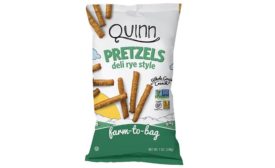ARTICLES
Consumers search for more protein and fiber in their diets.
Read More
Improving snacks and baked goods with healthy grain ingredients
New grain ingredients deliver flavor, function and nutrition
September 13, 2018
Healthy nuts, seeds and inclusions don’t compromise on taste
Nutritious inclusions make for delicious snack and bakery products.
August 7, 2018
State of the Industry 2018: Pretzel market shows growth
Today’s pretzels category is driven by clean label, better-for-you
July 18, 2018
Functional ingredients provide multiple benefits to snacks and baked goods
Ingredients like fats and oils, starches, dough conditioners and more form the backbone of snack and bakery formulations.
May 10, 2018
Transparency and healthy indulgence reign in the world of chocolate ingredients
Heath-conscious consumers are looking for chocolate to deliver a sensory, sensible and sustainable experience
April 5, 2018
Consumers looking for ethnic experiences create opportunity for innovation
Increased popularity of ethnic cuisines leads to consumer interest.
March 8, 2018
Fruit ingredients deliver flavor, color and nutritional benefits to snacks and baked goods
Fruit ingredients serve as building blocks for better snacks and baked goods.
February 6, 2018
Finding the right sweetener solutions to cut sugar in snacks and baked goods
Suppliers offer strategies for reducing sugar without compromising taste.
January 10, 2018
Dairy ingredient growth driven by desire for clean label, nutrition
Consumers search for wholesome dairy products.
December 11, 2017
View All Articles by Joyce Friedberg
Keep the info flowing with our eNewsletters!
Get the latest industry updates tailored your way.
JOIN TODAY!Copyright ©2024. All Rights Reserved BNP Media.
Design, CMS, Hosting & Web Development :: ePublishing









